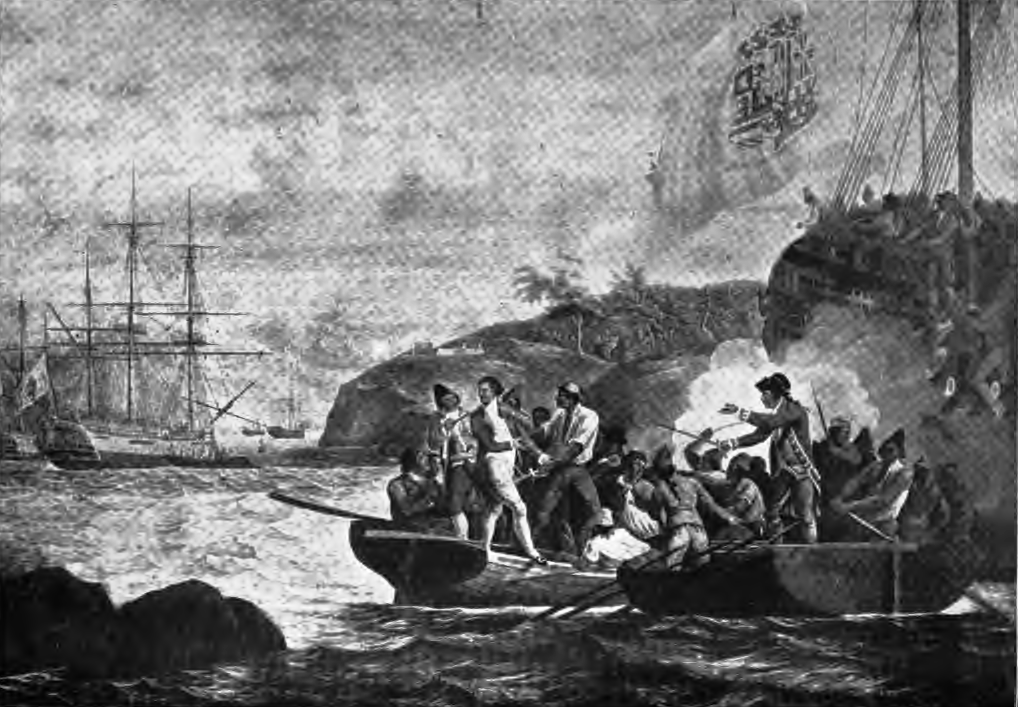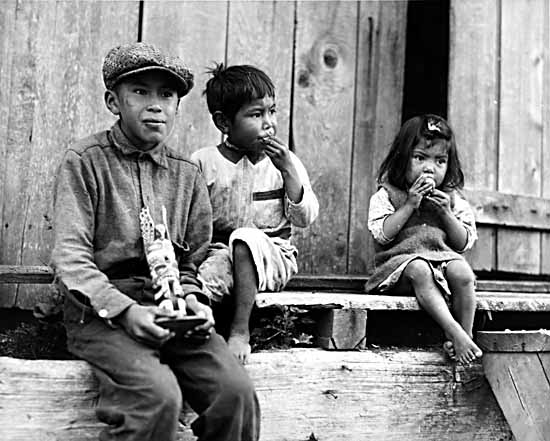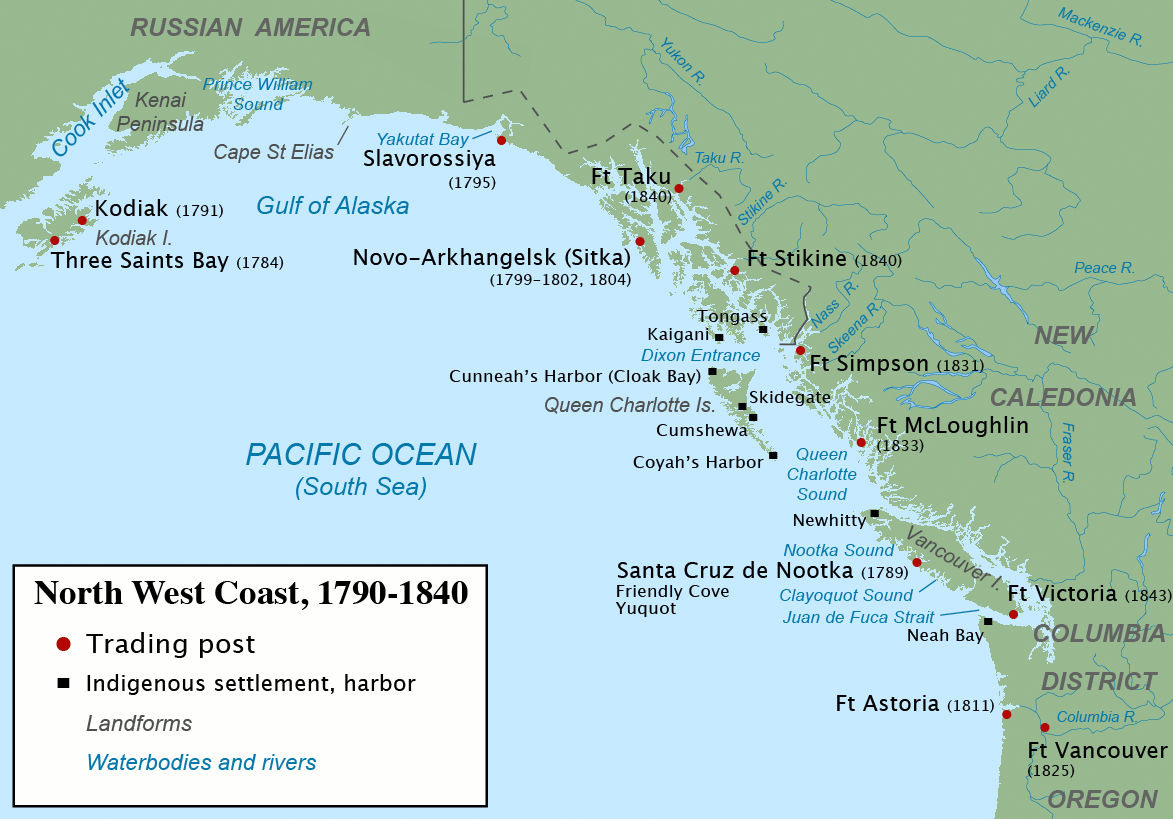|
Maquinna
Maquinna (also transliterated Muquinna, Macuina, Maquilla) was the chief of the Nuu-chah-nulth people of Nootka Sound, during the heyday of the maritime fur trade in the 1780s and 1790s on the Pacific Northwest Coast. The name means "possessor of pebbles". His people are today known as the Mowachaht and reside today with their kin, the Muchalaht, at Gold River, British Columbia, Canada. History Maquinna was a powerful chief whose summer coastal village, Yuquot, became the first important anchorage in the European jockeying for power and commerce as the era of the maritime fur trade began. Yuquot became known as Friendly Cove after the British explorer Captain James Cook visited in 1778. Cook did not record the name of the chief of Yuquot, who may not have been Maquinna in 1778, even though writers have often assumed it was. Imperial Spain had sent two voyages to the region before Cook's visit, including Juan Pérez, who in 1774 had anchored in or near the entrance of Nootka S ... [...More Info...] [...Related Items...] OR: [Wikipedia] [Google] [Baidu] |
Maquinna
Maquinna (also transliterated Muquinna, Macuina, Maquilla) was the chief of the Nuu-chah-nulth people of Nootka Sound, during the heyday of the maritime fur trade in the 1780s and 1790s on the Pacific Northwest Coast. The name means "possessor of pebbles". His people are today known as the Mowachaht and reside today with their kin, the Muchalaht, at Gold River, British Columbia, Canada. History Maquinna was a powerful chief whose summer coastal village, Yuquot, became the first important anchorage in the European jockeying for power and commerce as the era of the maritime fur trade began. Yuquot became known as Friendly Cove after the British explorer Captain James Cook visited in 1778. Cook did not record the name of the chief of Yuquot, who may not have been Maquinna in 1778, even though writers have often assumed it was. Imperial Spain had sent two voyages to the region before Cook's visit, including Juan Pérez, who in 1774 had anchored in or near the entrance of Nootka S ... [...More Info...] [...Related Items...] OR: [Wikipedia] [Google] [Baidu] |
Santa Cruz De Nuca
Santa Cruz de Nuca (or Nutca) was a Spanish colonial fort and settlement and the first European colony in what is now known as British Columbia. The settlement was founded on Vancouver Island in 1789 and abandoned in 1795, with its far northerly position making it the "high-water mark" of verified northerly Spanish settlement along the North American west coast. The colony was established with the Spanish aim of securing the entire west coast of the continent from Alaska southwards, for the Spanish crown. Due to the presence and activities of several British maritime fur trading ships in the same region, and the Russian colonization of Alaska further north, this Spanish attempt at making such a substantial claim for possession and conquest along the North American west coast failed. The colony was briefly abandoned between October 1789 and April 1790. In 1795 the colony was permanently abandoned following the settlement and signing of the Nootka Convention. This final Spanish ab ... [...More Info...] [...Related Items...] OR: [Wikipedia] [Google] [Baidu] |
Nootka Crisis
The Nootka Crisis, also known as the Spanish Armament, was an international incident and political dispute between the Nuu-chah-nulth Nation, the Spanish Empire, the Kingdom of Great Britain, and the fledgling United States of America triggered by a series of events revolving around sovereignty claims and rights of navigation and trade. It took place during the summer of 1789 at the Spanish outpost Santa Cruz de Nuca, in Nootka Sound on Vancouver Island in present-day British Columbia, Canada. The commander of the outpost, Jose Esteban Martínez, seized some British commercial ships which had come for the maritime fur trade and to build a permanent post at Nootka Sound. Public outcry in Britain led to the mobilization of the Royal Navy, and the possibility of war. Both sides called upon allies, the Dutch joined the side of Britain; Spain mobilized their navy and her key ally France also mobilized theirs, but the latter soon announced they would not go to war. Without French help ... [...More Info...] [...Related Items...] OR: [Wikipedia] [Google] [Baidu] |
Yuquot, British Columbia
Yuquot , also known as Friendly Cove, is a small settlement of around six people—the Williams family of the Mowachaht band—plus two full-time lighthouse keepers, located on Nootka Island in Nootka Sound, just west of Vancouver Island, British Columbia, Canada. It was the summer home of Chief Maquinna and the Mowachaht/Muchalaht (Nuu-chah-nulth) people for generations, housing approximately 1,500 people in 20 traditional wooden longhouses. The name means "Wind comes from all directions" in Nuu-chah-nulth. The community is located within the Strathcona Regional District but like all Indian Reserve communities is not governed by nor represented in the regional district. The Mowchaht/Muchalaht First Nations are rather part of the Nuu-chah-nulth Tribal Council, which unites the governments of the indigenous communities of the Island's West Coast. The Canadian government declared Friendly Cove a National Historic Site in 1923, with recognition of the significance of the Spanish c ... [...More Info...] [...Related Items...] OR: [Wikipedia] [Google] [Baidu] |
Nootka Sound
, image = Morning on Nootka Sound.jpg , image_size = 250px , alt = , caption = Clouds over Nootka Sound , image_bathymetry = , alt_bathymetry = , caption_bathymetry = Map of Nootka Sound , location = Vancouver Island, British Columbia , group = , coordinates = , type = Sound , etymology = , part_of = , inflow = , rivers = , outflow = , oceans = Pacific Ocean , catchment = , basin_countries = , agency = , designation = , date-built = , engineer = , date-flooded = , length = , width = , area = , depth = , max-depth = , volume = , residence_time = , salinity = , shore = , elevation = , temperature_hi ... [...More Info...] [...Related Items...] OR: [Wikipedia] [Google] [Baidu] |
Maritime Fur Trade
The maritime fur trade was a ship-based fur trade system that focused on acquiring furs of sea otters and other animals from the indigenous peoples of the Pacific Northwest Coast and natives of Alaska. The furs were mostly sold in China in exchange for tea, silks, porcelain, and other Chinese goods, which were then sold in Europe and the United States. The maritime fur trade was pioneered by Russians, working east from Kamchatka along the Aleutian Islands to the southern coast of Alaska. British and Americans entered during the 1780s, focusing on what is now the coast of British Columbia. The trade boomed around the beginning of the 19th century. A long period of decline began in the 1810s. As the sea otter population was depleted, the maritime fur trade diversified and transformed, tapping new markets and commodities, while continuing to focus on the Northwest Coast and China. It lasted until the middle to late 19th century. Russians controlled most of the coast of present-da ... [...More Info...] [...Related Items...] OR: [Wikipedia] [Google] [Baidu] |
James Colnett
James Colnett (1753 – 1 September 1806) was an officer of the British Royal Navy, an explorer, and a maritime fur trader. He served under James Cook during Cook's second voyage of exploration. Later he led two private trading expeditions that involved collecting sea otter pelts in the Pacific Northwest of North America and selling them in Canton, China, where the British East India Company maintained a trading post. Wintering in the recently discovered Hawaiian Islands was a key component of the new trade system. Colnett is remembered largely for his involvement in the Nootka Crisis of 1789—initially a dispute between British traders and the Spanish Navy over the use of Nootka Sound on Vancouver Island that became an international crisis that led Britain and Spain to the brink of war before being peacefully resolved through diplomacy and the signing of the Nootka Conventions. Due to Colnett's central role in the initial incident that sparked the international crisis, Colnet ... [...More Info...] [...Related Items...] OR: [Wikipedia] [Google] [Baidu] |
Fort San Miguel
Fort San Miguel was a Spanish fortification at Yuquot (formerly Friendly Cove) on Nootka Island, just west of north-central Vancouver Island. It protected the Spanish settlement, called Santa Cruz de Nuca, the first colony in British Columbia. History It was first built by Esteban José Martínez in 1789 but dismantled in October of that year. It was then rebuilt and enlarged in 1790 then Nootka Sound was reoccupied by Francisco de Eliza. The fort was essentially an artillery land battery for the defence of the harbour and buildings. The Spanish settlement, called Santa Cruz de Nuca, was the first colony in British Columbia. The fort lay near the home of Maquinna, chief of the Mowachaht group, who are now in the joint Mowachaht/Muchalaht First Nations band government with the Muchalaht at Gold River nearby on Vancouver Island. On May 15, 1789, Martínez chose the location of his fortification at the entrance of Friendly Cove on Hog Island. Work progressed so that on May 26 th ... [...More Info...] [...Related Items...] OR: [Wikipedia] [Google] [Baidu] |
Gold River, British Columbia
Gold River is a village municipality located close to the geographic centre of Vancouver Island in British Columbia, Canada. In terms of the Island's human geography it is considered to be part of the "North Island", even though it technically is on the Island's west coast. History Taking advantage of its deep water and abundant forests, Gold River developed in 1967 as a prototypical logging and pulp and paper industry community. Gold River quickly sprang into prosperity and established excellent community facilities. When shifting world markets brought the mill closure in 1998, many of Gold River's inhabitants were forced to relocate. Since then, the village has attempted to capitalize on its idealistic setting among picturesque mountains, lakes, rivers, ocean, and forests to develop tourism and sport fishing as its main economic supports. Currently, Gold River serves as a base for such famous activities as the Nootka Island trek, hiking the Elk Lake trail and mountain climbi ... [...More Info...] [...Related Items...] OR: [Wikipedia] [Google] [Baidu] |
John Meares
John Meares (c. 1756 – 1809) was an English navigator, explorer, and maritime fur trader, best known for his role in the Nootka Crisis, which brought Britain and Spain to the brink of war. Career Meares' father was Charles Meares, "formerly an attorney of great eminence, and for several years pursuivant of his Majesty's Court of Exchequer in Dublin". In 1771, Meares joined the Royal Navy as a captain's servant and was commissioned a lieutenant in 1778. In 1783 he joined the merchant service and in 1785, based in India, formed the ''Northwest America Company'' for collecting sea otter furs by trade with the indigenous peoples of the Pacific Northwest Coast and selling them in China. The East India Company held a monopoly on British trade in the Pacific and required all British traders to be licensed with the company and pay duties. Meares did not license his ships with the East India Company and instead tried to conceal the illegal activity by using the flag of Portugal. Meares r ... [...More Info...] [...Related Items...] OR: [Wikipedia] [Google] [Baidu] |
Mowachaht
The Mowachaht/Muchalaht First Nations are a First Nations government on the west coast of Vancouver Island in the Canadian province of British Columbia. The Mowachaht/Muchalaht First Nations are a member nation of the Nuu-chah-nulth Tribal Council, which spans all Nuu-chah-nulth-aht peoples (incorrectly known as "Nootka") except for the Pacheedaht First Nation. Their main reserve is at Gold River, British Columbia but the Mowachaht are originally from Yuquot on Nootka Sound, known to history as Friendly Cove, scene of the Nootka Incident and, later, the negotiations and eventual implementation of the Nootka Conventions between Britain and Spain, hosted by the Mowachaht chief Maquinna. Name The Mowachaht (pronounced ), which translates to people of the deer, originate from a place called Friendly Cove, or Yuquot (translates to "Wind comes from all directions"). The name Muchalaht translates to the people who hover over the river or the people over the river. History In the mid-t ... [...More Info...] [...Related Items...] OR: [Wikipedia] [Google] [Baidu] |
Nuu-chah-nulth People
The Nuu-chah-nulth (; Nuučaan̓uł: ), also formerly referred to as the Nootka, Nutka, Aht, Nuuchahnulth or Tahkaht, are one of the indigenous peoples of the Pacific Northwest Coast in Canada. The term Nuu-chah-nulth is used to describe fifteen related tribes whose traditional home is on the west coast of Vancouver Island. In precontact and early post-contact times, the number of tribes was much greater, but the smallpox epidemics and other consequences of settler colonization resulted in the disappearance of some groups and the absorption of others into neighbouring groups. The Nuu-chah-nulth are related to the Kwakwaka'wakw, the Haisla, and the Ditidaht First Nation. The Nuu-chah-nulth language belongs to the Wakashan family. The governing body is the Nuu-chah-nulth Tribal Council. History Contact with Europeans When James Cook first encountered the villagers at Yuquot in 1778, they directed him to "come around" (Nuu-chah-nulth ''nuutkaa'' is "to circle around")Campbe ... [...More Info...] [...Related Items...] OR: [Wikipedia] [Google] [Baidu] |







